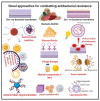Nanomedicine Fight against Antibacterial Resistance: An Overview of the Recent Pharmaceutical Innovations
- PMID: 32046289
- PMCID: PMC7076477
- DOI: 10.3390/pharmaceutics12020142
Nanomedicine Fight against Antibacterial Resistance: An Overview of the Recent Pharmaceutical Innovations
Abstract
Based on the recent reports of World Health Organization, increased antibiotic resistance prevalence among bacteria represents the greatest challenge to human health. In addition, the poor solubility, stability, and side effects that lead to inefficiency of the current antibacterial therapy prompted the researchers to explore new innovative strategies to overcome such resilient microbes. Hence, novel antibiotic delivery systems are in high demand. Nanotechnology has attracted considerable interest due to their favored physicochemical properties, drug targeting efficiency, enhanced uptake, and biodistribution. The present review focuses on the recent applications of organic (liposomes, lipid-based nanoparticles, polymeric micelles, and polymeric nanoparticles), and inorganic (silver, silica, magnetic, zinc oxide (ZnO), cobalt, selenium, and cadmium) nanosystems in the domain of antibacterial delivery. We provide a concise description of the characteristics of each system that render it suitable as an antibacterial delivery agent. We also highlight the recent promising innovations used to overcome antibacterial resistance, including the use of lipid polymer nanoparticles, nonlamellar liquid crystalline nanoparticles, anti-microbial oligonucleotides, smart responsive materials, cationic peptides, and natural compounds. We further discuss the applications of antimicrobial photodynamic therapy, combination drug therapy, nano antibiotic strategy, and phage therapy, and their impact on evading antibacterial resistance. Finally, we report on the formulations that made their way towards clinical application.
Keywords: anti-biofilm mechanisms; antibacterial resistance; inhibition of antibacterial resistance; inorganic nanosystems; nanomedicine; organic nanosystems.
Conflict of interest statement
This research received no external funding.
Figures



References
-
- Kourtis A.P., Hatfield K., Baggs J., Mu Y., See I., Epson E., Nadle J., Kainer M.A., Dumyati G., Petit S. Vital Signs: Epidemiology and Recent Trends in Methicillin-Resistant and in Methicillin-Susceptible Staphylococcus aureus Bloodstream Infections—United States. Morb. Mortal. Wkly. Rep. 2019;68:214. doi: 10.15585/mmwr.mm6809e1. - DOI - PMC - PubMed
-
- Livorsi D.J., Chorazy M.L., Schweizer M.L., Balkenende E.C., Blevins A.E., Nair R., Samore M.H., Nelson R.E., Khader K., Perencevich E.N. A systematic review of the epidemiology of carbapenem-resistant Enterobacteriaceae in the United States. Antimicrob. Resist. Infect. Control. 2018;7:55. doi: 10.1186/s13756-018-0346-9. - DOI - PMC - PubMed
Publication types
LinkOut - more resources
Full Text Sources
Molecular Biology Databases

